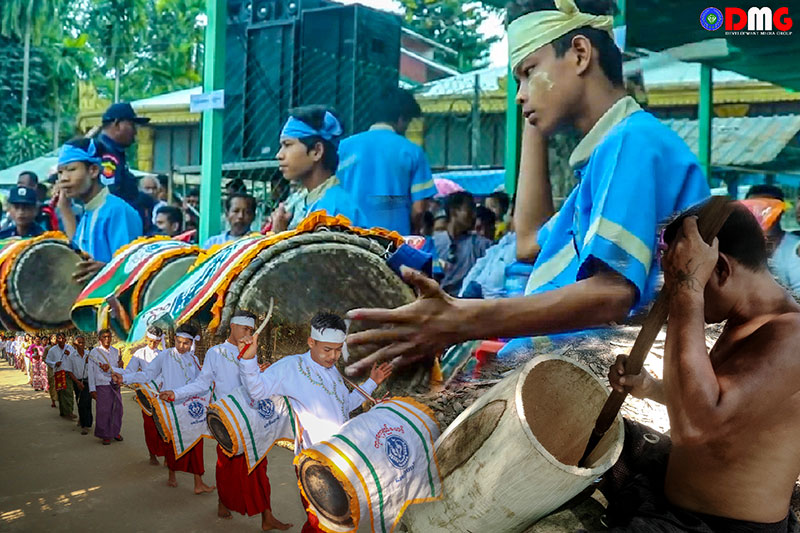- Junta unable to hold elections in dozens of wards and village-tracts in Sittwe, Kyaukphyu
- Fighting escalates between Myanmar military, Arakan Army in Ayeyarwady Region
- Regime steps up civilian arrests in Sittwe
- ULA safeguards Mrauk-U's ancient heritage
- Arakan on the Edge: What the DMG Landmine Impact Report Reveals About Myanmar's Deepening Humanitarian Crisis
Marching to the Beat of a Traditional Arakan Drum
“The Arakan traditional drum cannot be carved in the rainy season. ... The cowhide used to make an Arakan traditional drum needs to be out of the rain,” he explained.
10 Nov 2021

Written by Min Tun
U Maung Thar Aye uses a variety of carpentry tools to carve a 3-foot-long piece of wood into an Arakan traditional drum. The 50-something-year-old is one of a dwindling number of craftsmen able to make the instrument, which is cherished by many Arakanese people.
U Maung Thar Aye says that according to traditional Arakanese culture, there are three types of drums, based on three distinct sounds made by them.
“Wood is carved to make an Arakan traditional drum. The cowhide is soaked in water and put out in the sun. The cowhide surface is leveled and put in the water again to curve an Arakan traditional drum,” he tells DMG.
The Arakan traditional drum is carved of hardwoods such as Padauk and Peinhne. The front of the drum is covered with cowhide.
It takes about four days to carve an Arakan traditional drum, but production is seasonally constrained.
“The Arakan traditional drum cannot be carved in the rainy season. ... The cowhide used to make an Arakan traditional drum needs to be out of the rain,” he explained.
U Maung Thar Aye says he inherited the craft of making musical instruments, including the Arakan traditional drum, from his father U Thar Doe. At the age of 15, he began working with his father in the traditional drum-making business. U Thar Doe died when U Maung Thar Aye was 25 years old.
U Maung Thar Aye’s career as an Arakan traditional drum maker has spanned more than four decades.
“I work hard at carving these Arakan traditional drums, which are a part of Arakan culture. I do this work as part of my father’s legacy, and as a way of making a living,” he says.
U Maung Thar Aye said that when he began making Arakan traditional drums more than 40 years ago, the Arakanese people had little understanding of the value of preserving the cultural heritage of traditional instruments.
With this lack of appreciation, Arakan traditional drums were rarely used. Some people who carved Arakan traditional drums at the time, such as U Maung Thar Aye, also had to support their families by working as carpenters due to the scarcity of jobs and lack of regular work.
For the past 10 years or so, the Arakan traditional drum has become more popular, and the careers of those in the industry have improved.
“In the past, Arakan traditional drums were rarely used because of the low demand. As the Arakan traditional drum became more and more popular, we became more comfortable doing this work,” U Maung Thar Aye said.
Currently, Arakan traditional drums are being bought from various townships in Arakan State. In almost every town and village, Arakan traditional drum bands are popular.
Arakanese not only in Arakan State but also in Malaysia, Thailand, Australia and China have purchased Arakan traditional drums. The price of Arakan traditional drums range from K150,000 to K200,000, depending on size.
U Maung Thar Aye’s Arakan traditional drum business currently sells 20 to 50 drums per year.
The Arakan traditional drum is one of the oldest cultural heritage instruments of the Arakanese people and is an integral part of an Arakan traditional musical ensemble.
The Arakan traditional drum, which has been a part of royal court culture since the time of the ancient Arakanese kings, is still played at ceremonial events such as novitiation, donation and cultural ceremonies.
No matter how good the musicians may be, the creators of the Arakan traditional drum are the key to creating a melodious sound from an Arakan traditional drum.
But Arakan traditional drum makers are becoming increasingly scarce in Arakan State. Previously, there were artisans making Arakan traditional drums in Sittwe, Minbya, Mrauk-U and Kyauktaw townships. These days, there are only a handful of artisans making Arakan traditional drums in Mrauk-U and Kyauktaw townships.
U Maung Thar Aye, who lives in the Bandoola ward of Mrauk-U, is among those who fear the potential disappearance of the Arakan traditional drum-making business.
“If there is no one to make Arakan traditional drums, one of the traditional heritages of Arakanese people will disappear,” he said.
At least five drums are required when playing the drums ceremonially, with styles of play varying.
The use of the Arakan traditional drum is increasing, but the number of musicians who can play professionally is declining, said U Kyaw Zan Maung, a drum player from the Sai Dra Arakan traditional drum troupe in Sittwe.
U Kyaw Zan Maung says he has been playing Arakan traditional drums for about 40 years. He worries that the Arakan traditional drumming style will disappear as the number of disciplined players decreases.
“More and more people are playing Arakan traditional drums in a way that is not as their teachers used to teach them. This is because traditional drum troupes do not have control over traditional drumming techniques,” he said.
Intangible elements of cultural heritage can be lost completely if there is no one to pass them on, echoes Daw Ohnmar Myo, chairperson of the Myanmar Archaeology Association.
“If there is no one to preserve the heritage and there is no one to pass it on, the next generation won’t exist. If the heritage is not preserved, a piece of the Arakanese people’s heritage will disappear,” she said.
Cognizant of this, U Maung Thar Aye has taught his son the art of making Arakan traditional drums, passing on the knowledge of his ancestors.
“My son knows everything about making Arakan traditional drums. He is expected to be an Arakan traditional drum craftsman,” he said.
Ko Nyi Nyi Maung, the son of U Maung Thar Aye, has promised to continue the tradition, but U Maung Thar Aye is not ready to hand over the proverbial torch just yet.
“The job of making Arakan traditional drums was inherited from my father, so I thought I would do it as long as I could,” he says.




















